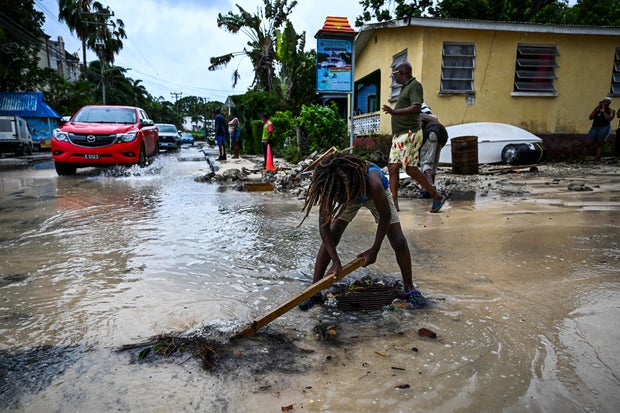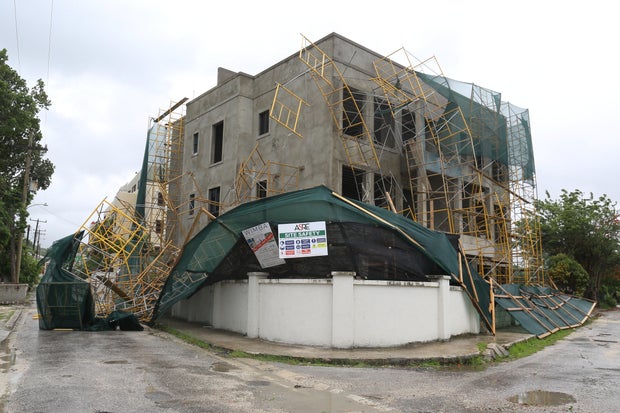Hurricane Beryl leaves trail of devastation in southeast Caribbean islands: "The situation is grim"
As Hurricane Beryl barreled through the Caribbean Sea on Tuesday, rescue crews in the southeast Caribbean fanned out across the region to determine the extent of the damage that the storm inflicted after making landfall on Carriacou, an island in Grenada, with Category 4 strength.
Three people were reported killed in Grenada and Carriacou and another in St. Vincent and the Grenadines, officials said. One fatality in Grenada occurred after a tree fell on a house, Kerryne James, minister of climate resilience, environment and renewable energy, told The Associated Press.
She said the nearby islands of Carriacou and Petit Martinique sustained the greatest damage, with water, food and baby formula a priority.
An emergency team was expected to travel to Carriacou, where Beryl flattened scores of homes and businesses.
"The situation is grim," Grenadian Prime Minister Dickon Mitchell told a news conference Tuesday. "There is no power, and there is almost complete destruction of homes and buildings on the island. The roads are not passable, and in many instances they are cut off because of the large quantity of debris strewn all over the streets."
Mitchell added: "The possibility that there may be more fatalities remains a grim reality as movement is still highly restricted."
Meanwhile, Ralph Gonsalves, prime minister of St. Vincent and the Grenadines, promised to rebuild the archipelago in a statement early Tuesday. He noted that 90% of homes on Union Island were severely damaged or destroyed, and that "similar levels of devastation" were expected on the islands of Myreau and Canouan.
Streets from St. Lucia island south to Grenada were strewn with tree limbs, downed power lines and other debris scattered by winds up to 150 mph — just shy of a Category 5. The storm snapped banana trees in half and killed cows that lay in green pastures as if they were sleeping. Homes made of tin and plywood tilted precariously nearby.
"Right now, I'm real heartbroken," said Vichelle Clark King as she surveyed her damaged shop in the Barbadian capital of Bridgetown that was filled with sand and water.
Beryl was forecast to start losing intensity on Tuesday but still be near major hurricane strength when it passes near or over Jamaica early Wednesday, near the Cayman Islands on Thursday and into Mexico's Yucatan Peninsula on Friday, according to the U.S. National Hurricane Center.
The last strong hurricane to hit the southeast Caribbean was Hurricane Ivan 20 years ago, which killed dozens of people in Grenada.
Grenadian resident Roy O'Neale, 77, recalled how he lost his home to Ivan and built back stronger, with his current home sustaining minimal damage from Hurricane Beryl.
"I felt the wind whistling, and then for about two hours straight, it was really, really terrifying at times," he said by phone. "Branches of trees were flying all over the place."
Hundreds of people hunkered in shelters across the southeast Caribbean, including 50 adults and 20 children who huddled inside a school in Grenada.
"Maybe some of them thought they could have survived in their homes, but when they realized the severity of it ... they came for cover," said Urban Mason, a retired teacher who served as the shelter's manager. "People tend to be complacent."
One of the homes that Beryl damaged belongs to the parents of U.N. Climate Change Executive Secretary Simon Stiell, who is from Carriacou. The storm also destroyed the home of his late grandmother.
In a statement, Stiell said that the climate crisis is going from bad to worse, and faster than expected.
"Whether in my homeland of Carriacou ... hammered by Hurricane Beryl, or in the heatwaves and floods crippling communities in some of the world's largest economies, it's clear that the climate crisis is pushing disasters to record-breaking new levels of destruction," he said.
Grenada officials had to evacuate patients to a lower floor after hospital roof was damaged, Mitchell said.
"There is the likelihood of even greater damage," he told reporters. "We have no choice but to continue to pray."
In Barbados, Wilfred Abrahams, minister of home affairs and information, said drones — which are faster than crews fanning across the island — would assess damage once Beryl passes.
Forecasters had warned of a life-threatening storm surge of up to 9 feet in areas where Beryl made landfall, with 3 to 6 inches of rain for Barbados and nearby islands and possibly 10 inches in some areas, especially in Grenada and the Grenadines.
Beryl strengthened from a tropical depression to a major hurricane in just 42 hours — a feat accomplished only six other times in Atlantic hurricane history, and with Sept. 1 as the earliest previous date, according to hurricane expert Sam Lillo.
It also was the earliest Category 4 Atlantic hurricane on record, besting Hurricane Dennis, which became a Category 4 storm on July 8, 2005 — and then set another record as the earliest to reach Category 5.
Beryl amassed its strength from record warm waters that are hotter now than they would be at the peak of hurricane season in September, said hurricane specialist and storm surge expert Michael Lowry.
Even as Beryl bore down on the southeast Caribbean, government officials warned about a separate cluster of thunderstorms mimicking the hurricane's path that have a 70% chance of becoming a tropical depression.
"There's always a concern when you have back-to-back storms," Lowry said. "If two storms move over the same area or nearby, the first storm weakens the infrastructure, so the secondary system doesn't need to be as strong to have serious impacts."
Beryl is the second named storm in the Atlantic hurricane season, which runs from June 1 to Nov. 30. Earlier this month, Tropical Storm Alberto made landfall in northeast Mexico and killed four people.
The National Oceanic and Atmospheric Administration predicts the 2024 hurricane season is likely to be well above average, with between 17 and 25 named storms. The forecast calls for as many as 13 hurricanes and four major hurricanes.
An average Atlantic hurricane season produces 14 named storms, seven of them hurricanes and three major hurricanes.








